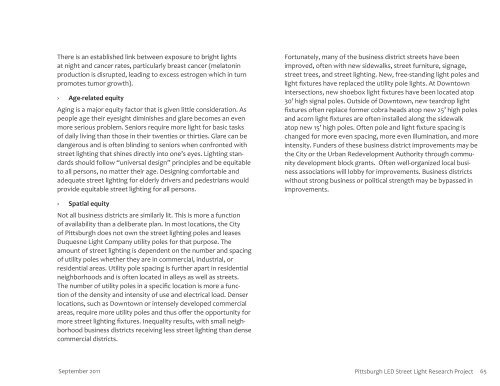LED Street Light Research Project
LED Street Light Research Project
LED Street Light Research Project
You also want an ePaper? Increase the reach of your titles
YUMPU automatically turns print PDFs into web optimized ePapers that Google loves.
There is an established link between exposure to bright lights<br />
at night and cancer rates, particularly breast cancer (melatonin<br />
production is disrupted, leading to excess estrogen which in turn<br />
promotes tumor growth).<br />
› Age-related equity<br />
Aging is a major equity factor that is given little consideration. As<br />
people age their eyesight diminishes and glare becomes an even<br />
more serious problem. Seniors require more light for basic tasks<br />
of daily living than those in their twenties or thirties. Glare can be<br />
dangerous and is often blinding to seniors when confronted with<br />
street lighting that shines directly into one’s eyes. <strong>Light</strong>ing standards<br />
should follow “universal design” principles and be equitable<br />
to all persons, no matter their age. Designing comfortable and<br />
adequate street lighting for elderly drivers and pedestrians would<br />
provide equitable street lighting for all persons.<br />
› Spatial equity<br />
Not all business districts are similarly lit. This is more a function<br />
of availability than a deliberate plan. In most locations, the City<br />
of Pittsburgh does not own the street lighting poles and leases<br />
Duquesne <strong>Light</strong> Company utility poles for that purpose. The<br />
amount of street lighting is dependent on the number and spacing<br />
of utility poles whether they are in commercial, industrial, or<br />
residential areas. Utility pole spacing is further apart in residential<br />
neighborhoods and is often located in alleys as well as streets.<br />
The number of utility poles in a specific location is more a function<br />
of the density and intensity of use and electrical load. Denser<br />
locations, such as Downtown or intensely developed commercial<br />
areas, require more utility poles and thus offer the opportunity for<br />
more street lighting fixtures. Inequality results, with small neighborhood<br />
business districts receiving less street lighting than dense<br />
commercial districts.<br />
September 2011<br />
Fortunately, many of the business district streets have been<br />
improved, often with new sidewalks, street furniture, signage,<br />
street trees, and street lighting. New, free-standing light poles and<br />
light fixtures have replaced the utility pole lights. At Downtown<br />
intersections, new shoebox light fixtures have been located atop<br />
30’ high signal poles. Outside of Downtown, new teardrop light<br />
fixtures often replace former cobra heads atop new 25’ high poles<br />
and acorn light fixtures are often installed along the sidewalk<br />
atop new 15’ high poles. Often pole and light fixture spacing is<br />
changed for more even spacing, more even illumination, and more<br />
intensity. Funders of these business district improvements may be<br />
the City or the Urban Redevelopment Authority through community<br />
development block grants. Often well-organized local business<br />
associations will lobby for improvements. Business districts<br />
without strong business or political strength may be bypassed in<br />
improvements.<br />
Pittsburgh <strong>LED</strong> <strong>Street</strong> <strong>Light</strong> <strong>Research</strong> <strong>Project</strong> 65


